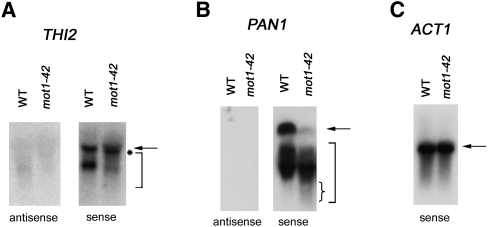Figure 5.
Confirmation of RNA length changes by Northern blotting. Total RNA from WT or mot1-42 cells was resolved by gel electrophoresis, transferred to nylon membrane, and probed with radiolabeled single DNA strands to detect gene-specific sense or antisense RNAs, as indicated. (A) THI2. Full-length RNA is indicated by the arrow. Note the slight shift in mobility of full-length RNA (indicated by the asterisk) and the smear of smaller RNA species (bracket) in mot1-42 versus WT samples. Only sense RNA was detected. The probes spanned +240 to +930 with respect to the start of the open reading frame. (For map of probe location, see Supplemental Fig. S8.) (B) PAN1 was identified as a Mot1-activated gene displaying premature termination in the differentially down class. Consistent with this, note the decrease in full-length RNA (arrow) in mot1-42 cells, which was in contrast to the shorter RNAs (large bracket) whose abundance was comparable in mot1-42 versus WT cells. However, the small RNA species were distributed such that the shortest RNAs were more prominent in mot1-42 cells compared with WT (denoted by small brace). Only sense RNA was detected. The probes spanned +420 to +864 with respect to the start of the ORF. (For screen shot of PAN1 tiling RNA signals and map of probe location, see Supplemental Fig. S8.) (C) ACT1 control RNA was detected with a sense-strand specific probe. As expected, discrete full-length bands were detected in both WT and mot1-42 cells, with no quantitative difference between them. The ACT1 probe spanned +14 to +184 with respect to the start of the ORF.

